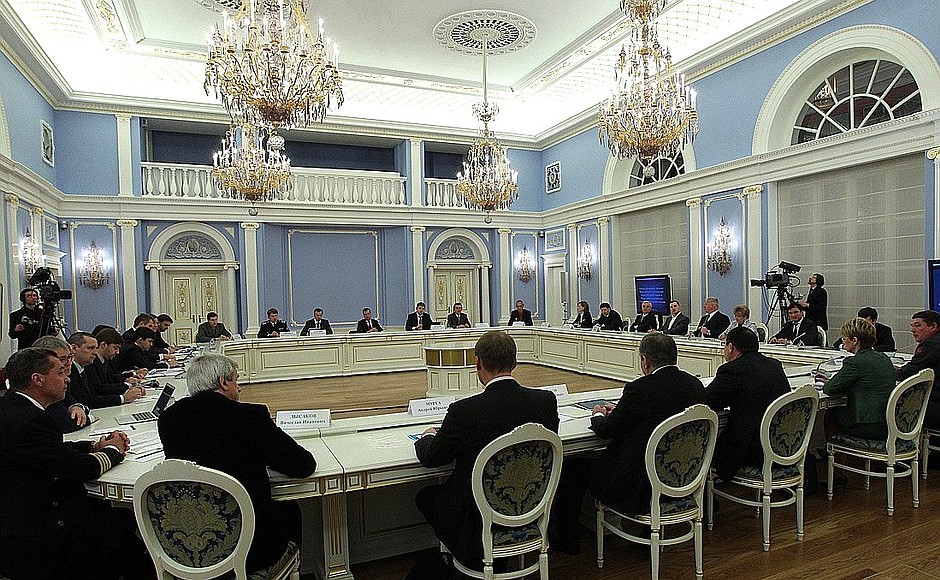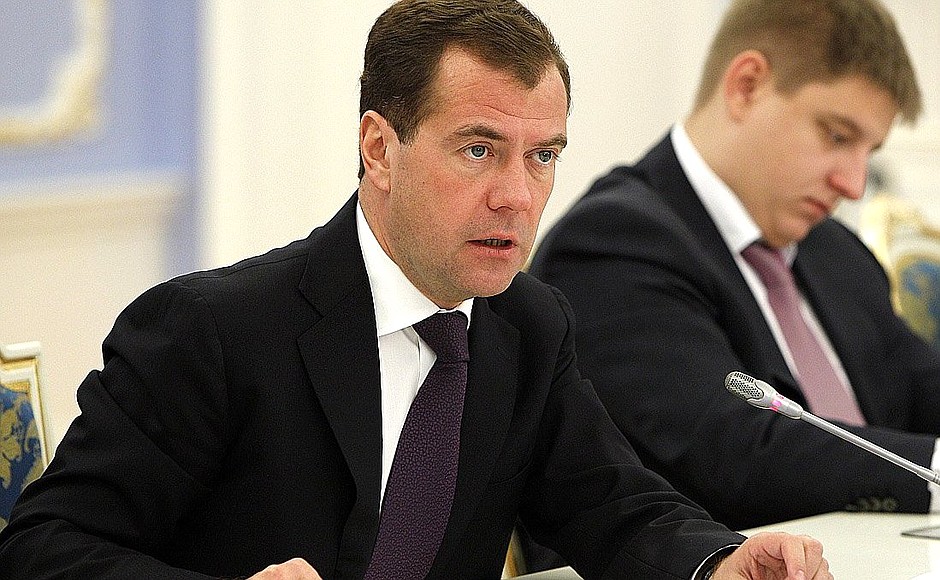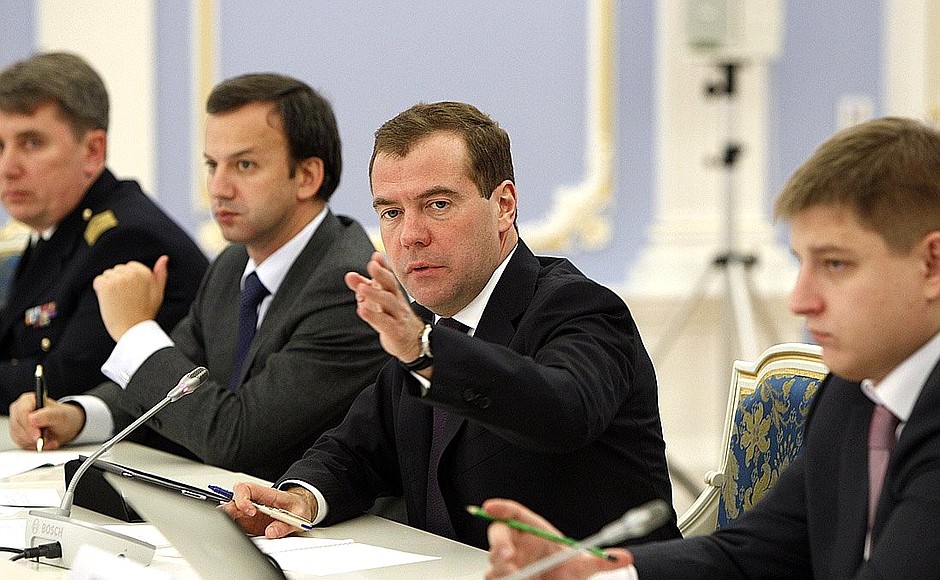Passenger and freight transport organisation and transport security measures were among the main subjects discussed at the meeting.
* * *
President of Russia Dmitry Medvedev: Colleagues,
During our meeting on October 19, we agreed to set workgroups, within the framework of the Public Committee and with active participation by United Russia, to prepare suggestions concerning particular areas of our national development, with the idea that now is the best time for this.
Today, we will discuss the transport situation. which has an enormous influence on the overall development of our economy, people’s quality of life, their emotional state, and their moods, because perhaps nothing exhausts the nerves as much as transport problems.
Our country must be linked by convenient supply lines. This is what everybody wants. We understand how difficult a challenge this is for our state, the largest in the world. We have done some work in this respect and it would be unfair to disregard it, but some major unresolved challenges and so-called systemic problems still remain. I will list them, and I ask that you clarify or add to the things that I say, express your ideas and suggestions. I want to note again that transport is certainly one of the most resonant areas attracting public attention. Our people write to me as President, appeal to the United Russia party, and turn to many public agencies, so we should respond.
The first topic is railroad development. For obvious reasons, railroads mean a lot more to us than to many other countries. They account for over 40 percent of freight traffic and 30 percent of passenger travel, and are essentially the infrastructural backbone that allows our nation to progress.
Millions of our people use trains. Certainly, train ticket prices should be reasonable and affordable while passengers should be able to easily and comfortably reach any destinations. We have great new examples in this domain, such as high-speed trains which have been launched to link St Petersburg, Moscow and Nizhny Novgorod. But today, this is more of an exception than the rule.
I would also like to discuss commuter trains, another highly relevant mode of transport. It is essential to support and develop it. I know that in the Moscow Region, there are new, modern models of domestically-produced rolling stock. I even saw some of them while visiting Moscow Region industries. They are equipped with air conditioners, normal chairs, and comfortable passageways. But again, this is still only the beginning.
In order to subsidise commuter companies, the federal budget will allocate 25 billion rubles ($800 million) to AO Russian Railways’ authorised capital in both 2011 and 2012. Let me point out that this is a lot of money. And accordingly, commuter passenger fares must remain affordable for the absolute majority of our people. At the same time, even now, we are to think about how this mechanism will work after 2012, because these 25 billion rubles per year are great, but we have to consider how the mechanism will function in the future.
The situation pertaining to freight traffic is clear, but I would like to specifically note that structural reorganisation within the framework of AO Russian Railways should not cause problems in freight shipments. This will ultimately determine the competitiveness of our economy. Let’s recall the situation we saw not long ago concerning the transportation of coal from Kuzbass coal areas, as well as grains from various places. This problem is partially resolved by now, but as far as I understand, there are still difficulties to this day. It would be helpful if you could tell me about it. No dounts, tariffs on shipments must remain at an acceptable level that does not undermine the competitiveness of our economy.
The second challenge is air transport: both intraregional and interregional. The general approach that I recently outlined is not up for review. I mean that we need to promote the growth of large, responsible air carriers that invest significant funding into development and the renewal of their aircraft fleet. People, our citizens, must have the opportunity to reach any part of the country by plane safely, comfortably, and at a reasonable cost. In this context, 2.5 billion rubles are being allocated to subsidising flights from the Far East to the European part of Russia. This way, the average ticket price decreased in 2010 and 2011. But this also involves certain complications.
Unfortunately, due to the degradation of small planes fleet, the main air carriers’ current route networks are designed in such a way that often people can only fly to neighbouring regions via Moscow. Everybody knows this. As a result, people must first fly into the capital, then fly back following nearly the same trajectory. This is very expensive and absolutely irrational. People lose time and a great deal of money. The way to overcome this is to create major hub airports. In particular, one such airport will be ready in 2013 in Krasnodar. But we cannot make our nation modern and developed transport-wise if we are unable to revive the use of small aircraft.
I looked at the figures today, and I was surprised: we have 28 thousand communities that can only be reached by plane or helicopter. 28 thousand! This is a very significant figure. In other words, there is no other way to get to those places: not by railroad, nor by automotive transport. So the state must support the development of social air service to hard-to-access areas. For example, 22 airfields in Yakutia were combined into the Airports of the North federal state-owned enterprise. At the very least, this allowed Yakutia to reduce aircraft service costs and build more rational traffic movement.
Besides, more than a billion rubles are being directed toward subsidising intraregional flights. But again, we are to create a system that will work more broadly between regions. Yakutia is enormous, and perhaps an intraregional system would be rational and understandable there, but in many cases, this kind of operation can unite several regions. Indeed, this might be the best way to go.
Third is water transport. As you know, water transportation has been and continues to be one of the most cost-effective modes of transport in the world. In many regions, rivers are key transport arteries, and we are obligated to ensure normal water traffic there. Again, everyone is aware of the situation. Our river fleet is worn out, the infrastructure is very bad, and the average vessel is over 30 years old. But even more important than age is serviceability status. Amendments were recently made to current legislation to support domestic shipping and shipbuilding. They stipulate lowering the tax burden on domestic manufacturers. Let me remind you that on October 21 of this year, a corresponding draft law was passed by the State Duma in its third reading.
The forth issue concerns security-related matters, which are always a priority and constitute a key requirement for all forms of transport. In accordance with my executive order of March 31, 2010, work is being conducted to design an integrated transport public security system. Its goal is to increase the efficacy of our infrastructure and resistance in possible emergency situations, including something as extreme as a terrorist attack. Over 46 billion rubles ($1.5 billion) have been allocated to finance this programme through 2013. Clearly, it would be unacceptable to take financial shortcuts when it comes to security, but at the same time, each ruble should be spent effectively, rather than to just check off some actions that change the security situation. Incidentally, this concerns all transport, including air, water, rail, and automotive transport.
As far as automotive transport is concerned, we have had a series of very bad road accidents just in the last several days. Of course, this is not the first time something of this sort has happened. Unfortunately, they happen regularly. And there are multiple causes; accidents are not just caused by bad transit and road conditions, which we should of course discuss, but drivers’ working conditions as well. And naturally, they also involve serious traffic regulations infractions, which constitute a major hurdle and complication for us.
Now, a little about the roads themselves. Even if the quality of the roads is changing, it is doing so very slowly. In many regions, the quality is awful, road capacity is low, and the roads are insufficient in number. Yes, this is a very difficult problem for us, because our country is enormous and we never properly invested in roads. So the road development programme on the national scale should be drafted for an extensive period. We will not be able to build roads in the course of two or three years, as much as we might like to, even if we have a great deal of capital. Nevertheless, it is important that road construction be reasonably priced, because road-building is a domain where only the lazy are not stealing, and all of this comes to light, quite quickly in fact. I mean the width of the roads, and the use of various components in particular proportions. Overall, we must monitor all of this, both through state supervision and law enforcement agencies. You know that we made a difficult decision on creating road funds on a federal level this year, and on a regional level beginning in 2012. I hope that they will also contribute to resolving this problem.
In addition, these should not simply be roadbeds, as sometimes (in fact, often) happens. Rather, in order to build modern roads, we need civilised infrastructure around roads, same as elsewhere in the world. I am also referring to problems pertaining to communications and ambulance services, emergency response, and a network of inexpensive cafeterias, restaurants, and motels that can be used by drivers.
Transport organisation requires particular attention in major cities, metropolises like Moscow, St Petersburg, and other cities with over a million people. Naturally, this also concerns traffic jams, which irritate everyone, as well as smog resulting from exhaust, and road construction. There is also the problem of public transport, which is currently used by 60 percent of our people. For the time being, this is the primary mode of transport for a majority of Russians. Thus, it must be accessible to the majority of our citizens, including disadvantaged groups. No doubt, it should also be more comfortable and have more regular operations.
This topic also concerns transport for disabled individuals. We have many people with limited mobility. Before, we simply didn’t care about this. Now, the situation has changed somewhat, at least in terms of accessibility requirements, so we must adapt our buses, trolley buses, subways, and other means of transport to meet disabled people’s needs. And here, we have to change our ways of thinking, not just on the part of civil servants, who may do so once they are ordered to, but perhaps even more importantly, the thinking and position of our society overall – the public’s attitudes toward the disabled – because in this sense, I must admit, our society is still far from the humanitarian standards applied in many other nations. The Accessible Environment government programme for 2011–2015 is aimed toward resolving this issue.
These are the topics I believe are quite important.
Colleagues, if you indicate any others, then I will be more than happy to hear them, because today’s discussion must ultimately aim toward various programmes of action for the short- and medium-term.
<…>


